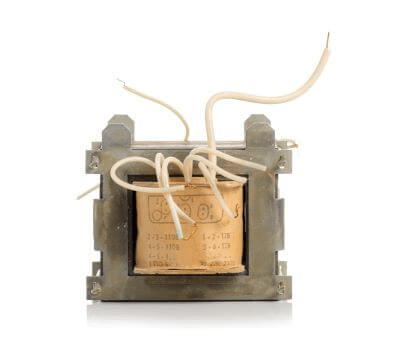What Is an Isolation Transformer?

An isolation transformer is a transformer in which the primary and secondary electrical circuits are not connected by conductors.
A transformer is used to change the power supply voltage. In a typical electric circuit, conductors are connected from the power source to the demand equipment. By using an isolation transformer, the conductors of the power source and the demand equipment can be separated.
Most transformers used for power supply are isolation transformers.
Uses of Isolation Transformers
Isolation transformers are used in a wide range of applications, from industrial power supplies to household power supplies.
Specific uses of isolation transformers:
- For power conversion in power plants and substations
- For lightning protection of office automation equipment
- For power supply for factories and commercial facilities
- Inside old AC adapters
- For power transmission in general households
- For noise reduction for semiconductor products
As mentioned above, isolation transformers are widely used for power transmission and distribution. They may also be installed for noise rejection and lightning protection.
Principle of Isolation Transformers
Isolation transformers are devices that transform and insulate using electromagnetic induction. They consist of primary and secondary windings, an iron core, and a casing.
The primary winding is the winding that receives voltage and power from the power supply. The iron core runs through the center of the winding, and the secondary winding runs through the same iron core. Because of this structure, electromagnetic induction works between the windings, and the voltage corresponding to the number of turns of the primary and secondary windings is supplied to the secondary windings.
The ratio of the number of turns of the primary and secondary windings is called the turn ratio. The more turns of the primary winding, the larger the turn ratio, the larger the turn ratio, the smaller the voltage received by the primary winding. Therefore, more power can be transmitted to the secondary winding.
Other Information on Isolation Transformers
1. Isolation Transformer and Non-isolation Transformer
Common power transformers are isolation transformers, but in rare cases, non-isolation transformers are used. Isolation transformers are transformers in which a portion of the primary winding is used for the secondary winding. Isolation transformers are also called single-winding transformers because of their construction.
Isolation transformers, on the other hand, are called double-wound transformers. Single-winding transformers are less expensive than double-winding transformers because they use less copper wire for the windings. However, since the primary side is not insulated from the secondary side, there is a risk that abnormal voltage on the primary side (e.g., lightning) will spread to the secondary side and destroy demand facilities. Single-winding transformers are used on top of overhead cranes and inside radios to reduce size.
2. Isolation Transformers and Noise
One of the purposes of using isolation transformers is to eliminate noise. However, ordinary isolation transformers can only remove low-frequency noise (common mode noise), not high-frequency noise (normal mode noise). To eliminate normal mode noise, transformers with electrostatic shielding on the primary and secondary windings are available.
As electrical equipment becomes more sophisticated and compact, circuits become closer together, and noise immunity tends to decrease. Noise introduced into electrical and electronic circuits can cause significant damage to system operation. Susceptibility to noise is a drawback of semiconductor components, which are becoming increasingly miniaturized.
Among them, controllers that control systems are less tolerant of noise due to the high integration of chips. If noise gets into such components, it can cause system malfunctions, internal data corruption, and the inability to recover data. Therefore, noise suppression measures such as the use of isolation transformers with electrostatic shielding are essential for semiconductor products.
3. Isolation Transformer and Grounding
Although the primary and secondary windings of an isolation transformer are insulated, there is a risk that the windings may become mixed up with each other in the event of an earthquake or other accident. If the windings become mixed up, there is a risk that the voltage on the high-voltage side will spread to the low-voltage side, resulting in an electric shock hazard.
For this reason, transformers of high voltage are required to have one grounding point on the low voltage side. The grounding used in this case is Class B grounding, which is connected to the low-voltage side neutral point of the isolation transformer and the anti-collision plate, etc. Applying Class B grounding to the isolation transformer makes it easier for the leakage detection equipment to detect leakage currents and also reduces the incoming voltage when there is a collision.